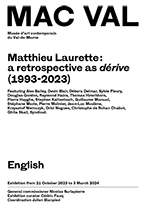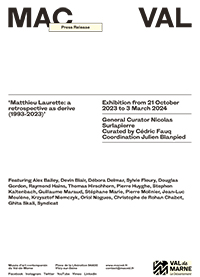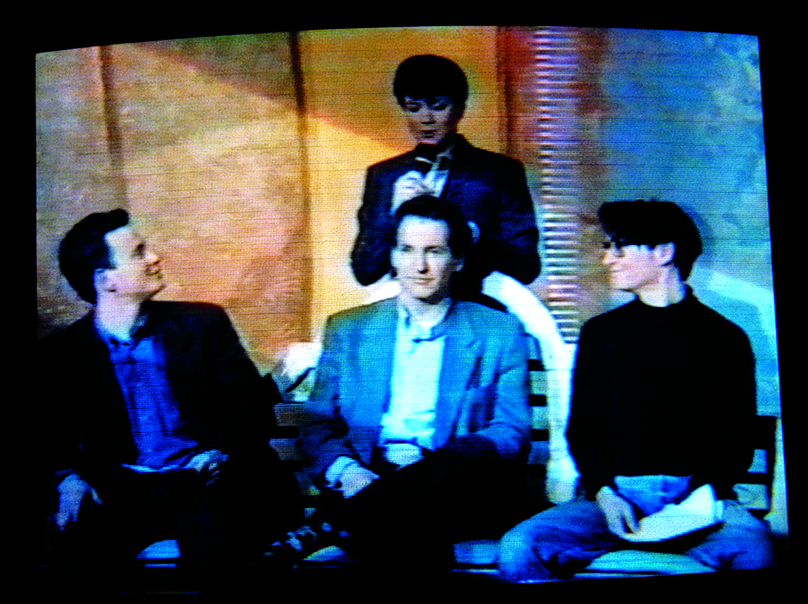The MAC VAL is welcoming Matthieu Laurette for a retrospective covering thirty years of artistic production and introducing a set of new works and interventions. Born in Val-de-Marne in 1970, Laurette is one of the leading figures of his generation. Winner of the Ricard prize in 2003, his work has been exhibited in major international institutions (Guggenheim, Centre Pompidou, Venice Biennale) and is held in numerous public and private collections. A protean artist, he uses the entertainment industry as raw material and the media (television, internet, press, etc.) as a means of producing and disseminating his work. Since 1993, he has been shifting the places where art is produced and exhibited in order to confront reality. Defining himself as a multimedia artist – his works take a variety of forms, from interventions on television and installations to recent developments on Instagram – he has developed a number of infiltration strategies at the intersection of conceptual art, popular culture, institutional critique, economic reflection and societal issues. Laurette uses existing mechanisms and contexts to create and insert his own works. He explores the complexity of the notion of value: of things, of the artist, of art and of money, even going so far as to make financial transactions the subject and material of his works. These call into question the place of art and the role of the artist in the age of the general spectacle.


Cédric Fauq, exhibition curator
This is Matthieu Laurette’s first solo exhibition in a French museum, and an opportunity to look back at the work of this artist who has already exhibited at the museum on several occasions as part of collective projects. Five works from his I AM AN ARTIST series are also held in the museum’s collection. Covering some thirty years of artistic production, ‘Matthieu Laurette: a retrospective as dérive (1993–2023)’ brings together a range of different types of work (installations, videos, apparitions, interventions, sculptures, photographs, contracts, works on paper, etc.), while at the same time developing a number of dérives (drifts), in other words, ways of thwarting and diverting the codified exercise of the retrospective exhibition, approaching the retrospective itself as a produit dérivé (spin-off).
On 16 March 1993, the candidates in TF1’s daily noon-time TV programme ‘Tournez manège’, in which men and women met without – initially – seeing each other, included Matthieu Laurette, a 22-year-old student at the École des Beaux-arts in Grenoble. Presenter Évelyne Leclerc asked him what he wanted to be when he was older. Laurette’s first answer was ‘artist’, but when asked again, he specified ‘multimedia artist’. In 1993, this term had yet to be associated with computing but referred to artists working in several media. As the programme was recorded before it was broadcast, Laurette had time to make up invitations and send them out, inviting people he knew and people from the French art world (whom he didn’t yet know) to watch him on TF1 at midday on 16 March. This was his first solo show. Laurette made the most of his television appearance and his statement. Around six million viewers watched this first Apparition.
This marked the beginning of a conceptual practice that would, in the years that followed, develop ideas about the exhibition as a medium and the spaces in which art is defined, and the modes of utterance that make it possible to call oneself an artist (between recognition by others and self-proclamation), in order to make the boundaries between the worlds of art (representation) and the real world (action) more porous. At the time, Laurette was already deeply influenced by Guy Debord’s thinking, as articulated in The Society of the Spectacle (1967). He even used this book as material for several of his works. Rejecting the term ‘performance’, he later described his practice as IRL Institutional Critique, adding to the name of this artistic modus operandi, the beginnings of which were identified as early as the late 1960s (institutional critique), the acronym of the expression ‘In Real Life’, originally used by online communities to designate the ‘real world’ (as opposed to the virtual world and fiction).
To make this IRL Institutional Critique possible, Laurette developed a set of modes of action and strategies: infiltration, appropriation, diversion, neutralisation. He used all the channels through which visual information circulates (print, television, internet, social networks, etc.), developing an aesthetic that feeds on advertising and the press (as Pop Art does), subverting the clinical and administrative coldness associated with conceptual art. In the 90s he produced a body of work around Produits Remboursés (Money-back Products): the idea was to turn the marketing operations (‘First purchase refunded’; ‘money back guarantee’, etc.) used to sell consumer products in supermarkets back against themselves, in order to live ‘refunded’ or, in other words, for free. Laurette used this action to create a buzz (as we would say nowadays): he appeared on television, on the cover of magazines, published a website, and toured several towns in France with his display truck and his Comment manger remboursé? talks to introduce people to this veritable way of life. From the Produits remboursés (Refunded Products) onwards, his work became intrinsically political, in both its communication methods and its content.
Laurette’s work thus crystallised around three issues: the circulation of images, art and money. Soon he was being invited to take part in exhibitions in France and abroad, at such highly respected venues as the Guggenheim in New York (1998) and the ICA in London (1999), as well as major events such as the 49th Venice Biennale in 2001 (curated by Harald Szeemann). In 2003 he was awarded the Ricard Foundation prize. This moment of institutional (and commercial) recognition led him to develop works that make the very condition of the artist (both geopolitical and economic) their content: Citizenship Project (1996 - ongoing); THINGS (Purchased with funds provided by) (2010–ongoing) and DEMANDS & SUPPLIES (2012–ongoing).
‘Matthieu Laurette: a retrospective as dérive (1993 - 2023)’ was conceived not as a linear chronological narrative but, as its title suggests, a dérive, with all its multiple meanings [drift, derivation]. This drift is both spatial and temporal: in the upper reaches of the retrospective space, advertising posters show images of Laurette’s exhibitions. Both souvenir photos and archives of the artist’s practice, they serve to anchor the retrospective, seeking to resituate the contexts in which the artist operated and to which his works are intimately linked. Four works previously seen at the MAC VAL will be installed exactly where they were originally shown. These ‘remakes’ sometimes conflict with the scenography of the exhibition preceding them (the contents of which have been retained for the retrospective), or even between different works. They are also an opportunity to invite other artists into the exhibition, neighbours who have previously exhibited Laurette’s work in other venues. In this way, the retrospective is conceived not just as a retrospective of works but as a retrospective of exhibitions (in which the acts of linking the works of curators of projects that have included Laurette are replayed to differing degrees).
In 1999, invited by Christian Bernard for a solo exhibition at the MAMCO in Geneva, Laurette took over the window displays to show a series of prints on A4 paper, set up on display stands. Each A4 sheet represented a work by the artist that was ‘available for sale’. This was already a form of retrospective, and Laurette has continued to conceive works that function as indexes to his body of work, thinking about the ‘availability ‘of his pieces, their circulation, their absence, as well as their reproduction or transformation. The most recent example is MATTHIEU: Une rétrospective dérivée, 1993 - 2015, a collaboration between Matthieu Laurette and the graphic design studio Syndicat (Sasha Léopold and François Havegeer), presented in this exhibition. Other gestures in the retrospective as dérive, new works will also function as condensed retrospectives, pieces that will contain, conceptually, all of Laurette’s work, conceived as Russian dolls. Another work (a sound piece) will highlight the absence of certain works, the ‘missing pieces’ in the exhibition. Finally, DRINKS BY: THE BEER, WINE AND OTHER ALCOHOL ART ARCHIVE (1999–in progress), a work by Matthieu Laurette in the form of a collection and independent exhibition, will be shown in the museum’s Salon area.
To coincide with and complement the exhibition ‘Matthieu Laurette: a retrospective as dérive (1993–2023)’, MAC VAL is publishing Matthieu Laurette: a monograph as derive (1993 –2023), a 336-page bilingual edition designed by Syndicat. It contains a major archive documenting Matthieu Laurette’s work, with essays by Julien Blanpied, Inès Champey, Dorothée Dupuis, Alex Farquharson, Cédric Fauq, Nicolas Surlapierre and numerous guests. The exhibition will also be the venue for a series of meetings, workshops, discussions and experiments aimed at a range of audiences, with a view to ensuring that the dérives keeping drifting on.
French site
Le MAC VAL accueille Matthieu Laurette pour une exposition rétrospective qui présente 30 années de production artistique et inclut un ensemble de nouvelles œuvres et interventions.

